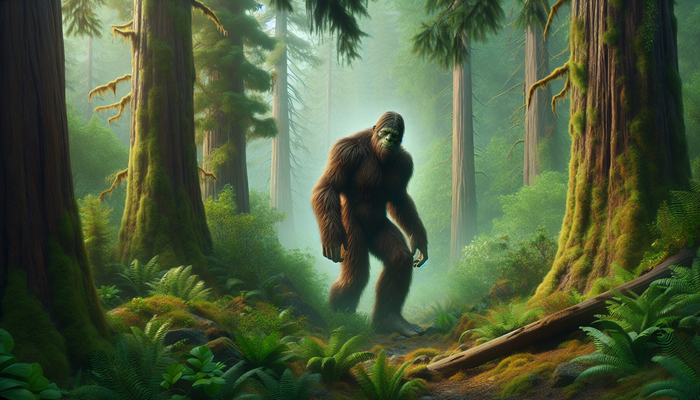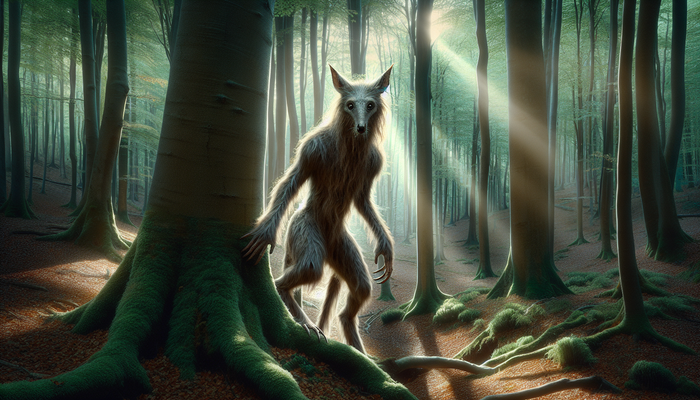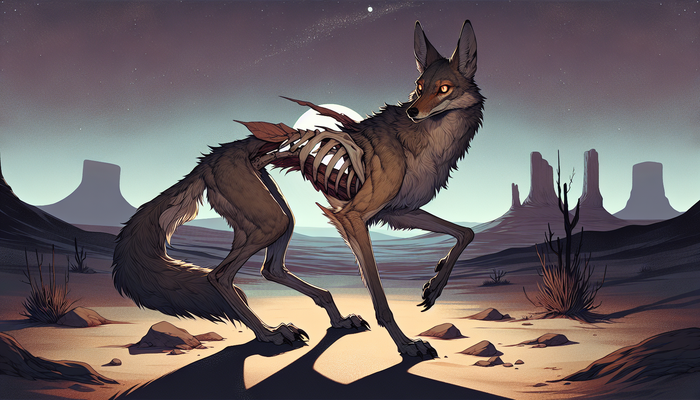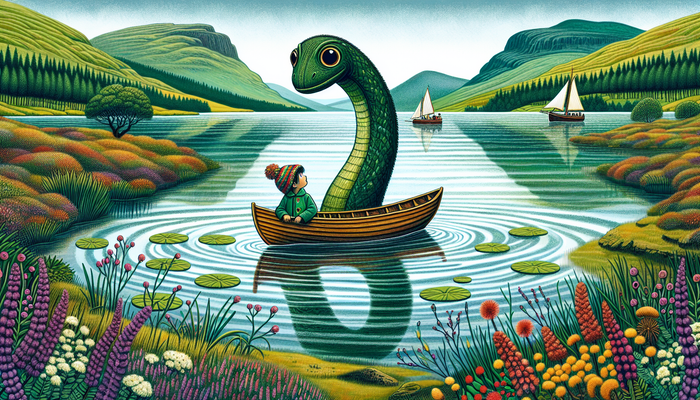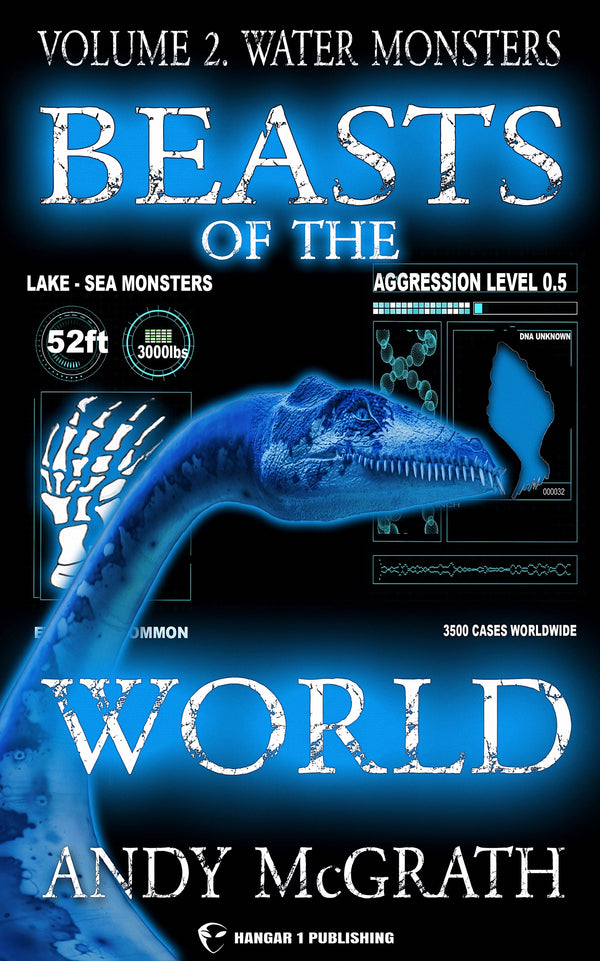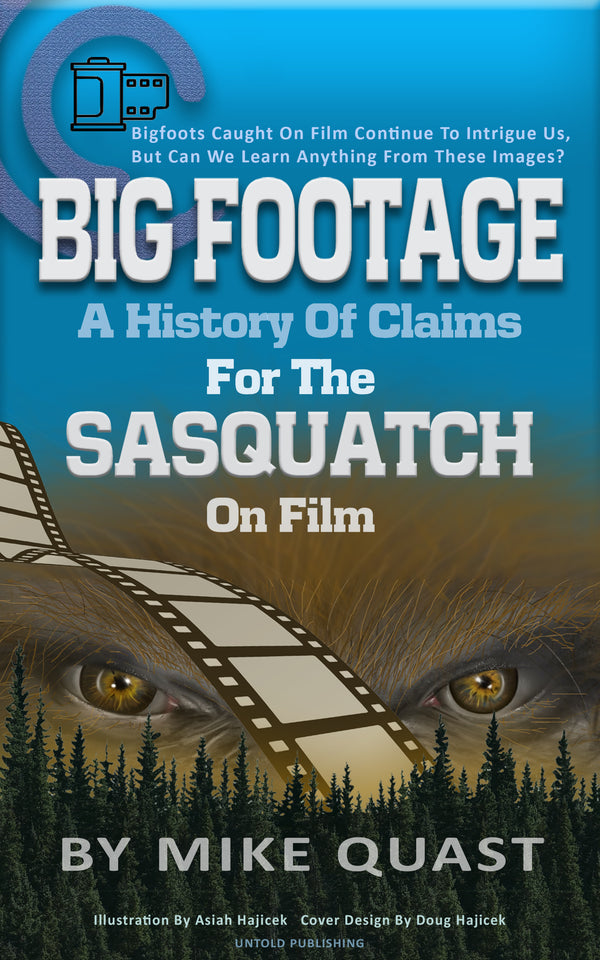Exploring Bigfoot's Interaction with Other Wildlife

By Dr. Elizabeth Harper, Cryptozoologist
Beyond the grainy photographs and contested footprint casts lies a fascinating question: If Bigfoot exists, how does it interact with the wildlife around it?
This question isn't just idle speculation. Understanding the potential ecological role of Bigfoot could shed light on complex ecosystem dynamics and challenge our perceptions of North American wildlife. From the Pacific Northwest to the Appalachian Mountains, reports of Bigfoot sightings often come hand-in-hand with descriptions of unusual animal behavior. These accounts paint a picture of a creature not just coexisting with known wildlife, but actively engaging with it in ways that blur the lines between predator, prey, and partner.
Consider the case of Mike MacDonald, a bear hunter who, in the spring of 1997, claimed to witness something extraordinary in the Fraser Canyon. MacDonald described seeing a large, bipedal creature that he initially mistook for a person. But as he watched, the being began to feed on willow buds and young leaves, reaching up with long arms to pull branches down to its mouth. This behavior, reminiscent of how gorillas feed in the wild, suggests a level of dexterity and intelligence that goes beyond what we typically associate with North American wildlife.
MacDonald's account is just one thread in a tapestry of stories that hint at Bigfoot's potential role as an omnivore in the forest ecosystem. If such a creature exists, it would likely need to consume a variety of food sources to sustain its large size, much like bears or other large primates. This dietary flexibility could explain why Bigfoot sightings often occur in areas rich with diverse plant life and animal populations.
The Ecological Role of Bigfoot
To truly understand how Bigfoot might interact with other wildlife, we must first consider its place in the food chain. Eyewitness accounts and folklore consistently describe Bigfoot as a large, powerful creature, capable of covering vast distances and adapting to various environments. This description aligns with what we know about apex predators and omnivores in other ecosystems.
Dr. Jeff Meldrum, a professor of anatomy and anthropology at Idaho State University and one of the few academics to seriously study Bigfoot, has proposed that if such a creature exists, it would likely be an omnivore with a diet similar to that of bears. This theory is supported by numerous reports of Bigfoot foraging for plants, berries, and even fish.
In October 1967, Glen Thomas reported observing a male Bigfoot digging a pit in Oregon's Cascade Range, from which it extracted and consumed ground squirrels. This behavior, if true, demonstrates not just predatory skills but also problem-solving abilities and tool use – traits we associate with higher primates.
The idea of Bigfoot as an omnivore opens up intriguing possibilities for its interactions with other species. Like bears, Bigfoot could play a crucial role in seed dispersal, helping to maintain forest diversity by consuming fruits and excreting seeds far from their source. This ecological function could explain why Bigfoot sightings often cluster in areas of rich biodiversity.
But Bigfoot's potential impact on the ecosystem doesn't stop at plant life. Reports of the creature's interactions with other animals paint a complex picture of predation, competition, and even cooperation.
Interactions with Predators
One of the most fascinating aspects of Bigfoot lore is its alleged relationship with other large predators, particularly bears and wolves. In many Bigfoot hotspots, these interactions seem to go beyond mere coexistence, hinting at a deeper understanding between species.
The Coyote Connection
Coyotes feature prominently in many Bigfoot encounters, often described as vocalizing in the same areas where Bigfoot is spotted. Some researchers, like Cliff Barackman, a former cast member of the television show "Finding Bigfoot," have noted a curious pattern: coyote calls sometimes precede or follow alleged Bigfoot vocalizations.
This phenomenon has led to speculation about a possible symbiotic relationship between Bigfoot and coyotes. Could coyotes be acting as scouts or scavengers, benefiting from Bigfoot's hunting prowess? The idea isn't as far-fetched as it might seem. Throughout history, humans have observed similar relationships between different predator species in the wild.
Take, for example, the relationship between wolves and ravens in Yellowstone National Park. Ravens often follow wolf packs, scavenging from their kills and even alerting wolves to the presence of prey or danger. If Bigfoot exists, it's not inconceivable that it could have developed a similar relationship with coyotes over time.
Bears and Bigfoot
The relationship between Bigfoot and bears is another area of intense speculation. Given that both are large, omnivorous creatures that would compete for similar resources, one might expect frequent conflicts. However, many Bigfoot researchers report a surprising lack of antagonism between the two species.
John Bindernagel, a wildlife biologist who spent years studying Bigfoot reports, noted that in areas with high bear populations, Bigfoot sightings often increase. Rather than indicating competition, this could suggest that the two species have learned to coexist, perhaps even benefiting from each other's presence.
One theory proposes that Bigfoot and bears may have a mutual understanding of territory. Just as different bear species in the same area will often avoid direct confrontation, Bigfoot might have developed a similar strategy for coexistence. This could explain why Bigfoot is often reported in bear country, yet direct conflicts between the two are rarely mentioned in eyewitness accounts.
The potential for communication between Bigfoot and other predators is another fascinating area of study. Some researchers have suggested that Bigfoot may be capable of mimicking the calls of other animals, including bears and coyotes. If true, this ability could serve multiple purposes: avoiding conflict, coordinating hunting efforts, or even misdirecting human observers.
Bigfoot and Domestic Animals
While interactions between Bigfoot and wild animals provide intriguing insights into its potential ecological role, reports of encounters with domestic animals add another layer of complexity to the creature's behavior.
Encounters with Horses
Some of the most bizarre Bigfoot stories involve horses. In certain Native American folklore, there are tales of Bigfoot attempting to mate with horses. While these stories may seem outlandish, they reflect a broader theme of Bigfoot's apparent curiosity towards domesticated animals.
More credible reports describe horses becoming agitated or fearful in areas where Bigfoot sightings are common. This behavior is similar to how horses react to the presence of large predators, suggesting that if Bigfoot exists, it may be perceived as a threat by these animals.
In 1924, a group of miners in Ape Canyon, Washington, reported being attacked by "ape-men" after shooting at one near their cabin. Interestingly, they mentioned that their horses had been acting strangely and refusing to venture into certain areas of the forest in the days leading up to the incident. While this story has been debated for decades, it highlights the potential for Bigfoot to impact the behavior of domesticated animals in wild settings.
Dogs and Bigfoot
Dogs feature prominently in many Bigfoot encounters, often serving as early warning systems for their human companions. Numerous reports describe dogs becoming agitated, fearful, or aggressive in areas where Bigfoot is later sighted or heard.
In 2000, a family camping in the Ocala National Forest in Florida reported that their normally calm dog became extremely agitated, growling and barking at something in the woods. Shortly after, they heard heavy footsteps and wood knocks, classic signs of alleged Bigfoot activity. The dog's behavior in this case mirrors how canines often react to the presence of large predators, suggesting that if Bigfoot exists, it may emit scents or sounds that trigger a fear response in dogs.
However, not all dog-Bigfoot interactions are negative. Some Bigfoot researchers have reported instances where dogs seem curious rather than fearful, even approaching areas where Bigfoot activity is suspected. This varied response could indicate that, like humans, individual Bigfoot may have different temperaments or attitudes towards other species.
The Symbiotic Relationships
The concept of symbiosis – mutually beneficial relationships between different species – is well-established in biology. If Bigfoot exists, it's possible that it has developed such relationships with other wildlife over time.
Scavenging Partnerships
One of the most intriguing theories about Bigfoot's interactions with wildlife involves scavenging partnerships. Just as bears often attract smaller scavengers to their kills, Bigfoot could play a similar role in the ecosystem.
Reports of ravens and crows following Bigfoot are particularly interesting in this context. These intelligent birds are known to form complex relationships with other predators, often leading them to food sources or alerting them to potential threats. In 2019, a hiker in the Olympic National Forest claimed to see two ravens circling and following a large, bipedal creature through the woods. While this sighting is unverified, it aligns with known behaviors of corvids in relation to other large predators.
If such partnerships exist, they could have far-reaching effects on the ecosystem. Bigfoot, as a potential apex predator, could influence the distribution of carrion throughout its range, affecting not just scavengers but also the nutrient cycling in the forest itself.
Communication and Coordination
The idea that Bigfoot might communicate or coordinate with other species is perhaps one of the most fascinating aspects of its potential interactions with wildlife. Some researchers have proposed that Bigfoot uses a complex system of vocalizations, not just to communicate with its own kind, but possibly with other animals as well.
Wood knocks, often associated with Bigfoot activity, could serve multiple purposes in this context. They might be used to signal territory, coordinate movement, or even to flush out prey. If Bigfoot is capable of mimicking the calls of other animals, as some reports suggest, this could be a powerful tool for hunting or avoiding detection.
In 2015, a group of researchers in the Ouachita Mountains of Oklahoma reported hearing a series of wood knocks followed by coyote howls, and then what they described as a loud, primate-like vocalization. While this evidence is anecdotal, it suggests the possibility of complex acoustic interactions between Bigfoot and other forest dwellers.
Cultural Perspectives on Bigfoot's Interactions
The stories we tell about Bigfoot and its relationship with other animals aren't just entertaining folklore; they're windows into how different cultures perceive the natural world and our place in it.
Indigenous Folklore
Many Native American tribes have rich traditions of wild men or hairy giants living in the forests. These beings are often described as having deep connections to the natural world, including the ability to communicate with animals.
The Lakota people, for example, tell stories of the Chiye-tanka, or "Big Elder Brother," a creature that can speak to both animals and humans. This being is said to act as a mediator between the human and animal worlds, embodying the interconnectedness of all living things.
Similarly, the Salish people of the Pacific Northwest speak of the Sasquatch as a guardian of nature, capable of controlling animals and punishing those who disrespect the forest. These stories reflect a worldview in which humans are just one part of a complex ecological web, with Bigfoot serving as a powerful symbol of wild nature.
Modern Interpretations
In contemporary culture, the idea of Bigfoot interacting with wildlife has taken on new significance. For some, it represents a lost connection to the natural world, a reminder of a time when humans lived in closer harmony with nature.
Bigfoot researchers often speak of the creature's apparent intelligence and adaptability, traits that would be necessary for a large, undiscovered primate to survive in North America's forests. The idea that such a being could exist, forming complex relationships with other species, challenges our understanding of wildlife and ecosystems.
This fascination has led to a surge in Bigfoot-related tourism and conservation efforts. In some areas, the search for Bigfoot has inadvertently contributed to wildlife conservation, as researchers and enthusiasts push for the protection of potential Bigfoot habitats.
Evidence and Skepticism
Despite the wealth of anecdotal evidence and cultural significance, the scientific community remains skeptical about Bigfoot's existence, let alone its interactions with other wildlife. The lack of conclusive physical evidence – no bodies, no clear photographs, no DNA that can't be attributed to known species – is a significant hurdle for Bigfoot researchers.
Critics argue that many Bigfoot sightings can be explained by misidentification of known animals, particularly bears. A 2009 study published in the Journal of Biogeography found that reported Bigfoot sightings closely matched the geographical distribution of black bears, suggesting that many encounters might be cases of mistaken identity.
However, proponents of Bigfoot's existence argue that the absence of evidence is not evidence of absence. They point to the vast, remote wilderness areas of North America, where even known species can go undetected for long periods. The discovery of new large animal species, like the saola in Vietnam in 1992, is often cited as proof that significant discoveries are still possible.
The Role of Anecdotal Reports
While anecdotal evidence is not considered scientifically rigorous, it plays a crucial role in the study of Bigfoot and its potential interactions with wildlife. Eyewitness accounts, while subjective, can provide valuable insights into animal behavior and ecological relationships that might otherwise go unnoticed.
Take, for example, the numerous reports of unusual animal behavior preceding Bigfoot sightings. While these accounts don't prove Bigfoot's existence, they do highlight the complex ways in which wildlife responds to the presence of large predators. This information can be valuable for wildlife biologists studying predator-prey dynamics and animal communication.
Research and Exploration
Despite the challenges, research into Bigfoot and its potential ecological role continues. Organizations like the Bigfoot Field Researchers Organization (BFRO) conduct regular expeditions into potential Bigfoot habitats, using a combination of traditional wildlife observation techniques and more specialized methods like audio recording and thermal imaging.
These efforts, while primarily focused on finding evidence of Bigfoot itself, often yield interesting data about wildlife behavior and forest ecosystems. For example, long-term audio monitoring in alleged Bigfoot hotspots has captured a wide range of animal vocalizations, providing valuable information about species distribution and behavior.
Some researchers are taking a more indirect approach, focusing on the ecological niches that a large, omnivorous primate might fill in North American forests. By studying the diet, range, and behavior of known large omnivores like bears, they hope to gain insights into how a creature like Bigfoot might interact with its environment.
The Mystery and Imagination
Regardless of whether Bigfoot exists, the enduring fascination with this creature and its potential relationships with wildlife speaks to something deep in the human psyche. It represents our desire to believe that there are still mysteries in the world, that nature still holds secrets we have yet to uncover.
The study of Bigfoot's interactions with wildlife, whether based in fact or folklore, encourages us to look at ecosystems in new ways. It challenges us to consider the complex, often invisible relationships between species and the delicate balance that exists in healthy forests.
As we continue to explore the wilderness areas of North America, we must remain open to the possibility of discovery. Whether or not Bigfoot is ever proven to exist, the search for this elusive creature has already yielded valuable insights into wildlife behavior, forest ecology, and our own relationship with the natural world.
In the end, the legend of Bigfoot and its interactions with wildlife serves as a powerful reminder of the wonders that still exist in our forests. It encourages us to approach nature with curiosity, respect, and a sense of wonder, always ready to be surprised by what we might find in the shadows of the trees.
From Bigfoot to UFOs: Hangar 1 Publishing Has You Covered!
Explore Untold Stories: Venture into the world of UFOs, cryptids, Bigfoot, and beyond. Every story is a journey into the extraordinary.
Immersive Book Technology: Experience real videos, sights, and sounds within our books. Its not just reading; its an adventure.



